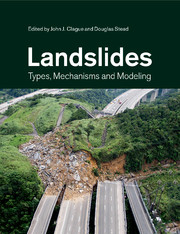Book contents
- Landslides
- Landslides
- Copyright page
- Contents
- Contributors
- Preface
- 1 Landslide hazard and risk
- 2 Landslides in the Earth system
- 3 Earthquake ground motion and patterns of seismically induced landsliding
- 4 Landslides at stratovolcanoes initiated by volcanic unrest
- 5 Mobility of long-runout rock avalanches
- 6 Rapid rock-slope failures
- 7 Risk assessments for debris flows
- 8 Landslides in quick clay
- 9 Controls on the distribution of major types of submarine landslides
- 10 Tsunami hazard assessment related to slope failures in coastal waters
- 11 Physical impacts of climate change on landslide occurrence and related adaptation
- 12 Landslides and geologic environments
- 13 Numerical modeling of rock-slope instability
- 14 Remote sensing techniques and landslides
- 15 Engineering geomorphology of landslides
- 16 Developments in landslide runout prediction
- 17 Models of the triggering of landslides during earthquakes
- 18 Slow rock-slope deformation
- 19 Landslide monitoring:
- 20 Groundwater in slopes
- 21 Soil slope stabilization
- 22 Rockfall characterization and modeling
- 23 The 2006 Eiger rockslide, European Alps
- 24 Randa:
- 25 Characterization and management of rockslide hazard at Turtle Mountain, Alberta, Canada
- 26 The Åknes rockslide, Norway
- 27 A seismometric approach for back-analyzing an unusual rockfall in the Apennines of Italy
- 28 Downie Slide, British Columbia, Canada
- 29 The 1963 Vaiont landslide, Italy
- 30 Hong Kong landslides
- 31 Landslides induced by the Wenchuan earthquake
- 32 Landslides on other planets
- Index
31 - Landslides induced by the Wenchuan earthquake
Published online by Cambridge University Press: 05 May 2013
- Landslides
- Landslides
- Copyright page
- Contents
- Contributors
- Preface
- 1 Landslide hazard and risk
- 2 Landslides in the Earth system
- 3 Earthquake ground motion and patterns of seismically induced landsliding
- 4 Landslides at stratovolcanoes initiated by volcanic unrest
- 5 Mobility of long-runout rock avalanches
- 6 Rapid rock-slope failures
- 7 Risk assessments for debris flows
- 8 Landslides in quick clay
- 9 Controls on the distribution of major types of submarine landslides
- 10 Tsunami hazard assessment related to slope failures in coastal waters
- 11 Physical impacts of climate change on landslide occurrence and related adaptation
- 12 Landslides and geologic environments
- 13 Numerical modeling of rock-slope instability
- 14 Remote sensing techniques and landslides
- 15 Engineering geomorphology of landslides
- 16 Developments in landslide runout prediction
- 17 Models of the triggering of landslides during earthquakes
- 18 Slow rock-slope deformation
- 19 Landslide monitoring:
- 20 Groundwater in slopes
- 21 Soil slope stabilization
- 22 Rockfall characterization and modeling
- 23 The 2006 Eiger rockslide, European Alps
- 24 Randa:
- 25 Characterization and management of rockslide hazard at Turtle Mountain, Alberta, Canada
- 26 The Åknes rockslide, Norway
- 27 A seismometric approach for back-analyzing an unusual rockfall in the Apennines of Italy
- 28 Downie Slide, British Columbia, Canada
- 29 The 1963 Vaiont landslide, Italy
- 30 Hong Kong landslides
- 31 Landslides induced by the Wenchuan earthquake
- 32 Landslides on other planets
- Index
Summary
A large number of landslides were triggered by the 2008 Mw 7.9 Wenchuan earthquake, which was accompanied by 270 km of surface rupture along the Longmenshan fault at the eastern margin of the Tibetan Plateau. The landslides were strongly controlled by geology, geomorphology, and earthquake shaking. They were concentrated on the hanging walls of the fault ruptures, and their directions seem to have been affected by the directivity of seismic waves. Landslides were also concentrated within the inner gorge of Minjian River. Carbonate rocks failed preferentially, probably due to their low shear resistance, caused in part by dissolution. A power function defines the relationship between the cumulative number of landslides and landslide area. The largest landslide, with an estimated volume of 0.8 km3, occurred on a cataclinal slope of carbonate rocks and was preceded by slow gravitational slope deformation. The second-largest landslide occurred in carbonate rocks on an undercut slope. Another large landslide had a long runout due to liquefaction and entrainment of sandy valley-bottom sediments. More than 800 of the landslides triggered by the earthquake blocked watercourses and impounded lakes.
- Type
- Chapter
- Information
- LandslidesTypes, Mechanisms and Modeling, pp. 383 - 392Publisher: Cambridge University PressPrint publication year: 2012
- 2
- Cited by



